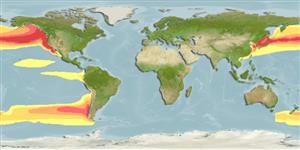>
Scombriformes (Mackerels) >
Centrolophidae (Medusafishes)
Etymology: lockingtoni: Named after W.N. Lockington, ichthyologist at the CAS (Ref. 6885).
Eponymy: William Neale Lockington (1840–1902) was a British zoologist and ichthyologist, as well as an architect. [...] (Ref. 128868), visit book page.
More on authors: Jordan & Gilbert.
Environment: milieu / climate zone / depth range / distribution range
Ökologie
seewasser; tiefenbereich 0 - 900 m (Ref. 50610). Subtropical; 60°N -
North Pacific: Japan and Gulf of Alaska to central Baja California, Mexico.
Size / Gewicht / Alter
Maturity: Lm ? range ? - ? cm
Max length : 46.0 cm TL Männchen/unbestimmt; (Ref. 6885)
Rückenflossenstacheln (insgesamt) : 3; Rückenflossenweichstrahlen (insgesamt) : 34 - 39; Afterflossenstacheln: 3; Afterflossenweichstrahlen: 20 - 25. Caudal rounded with small notch, narrow; pectorals small, rounded (Ref. 6885). Bluish gray to brown, darker on scale pockets, fins dusky to black (Ref. 6885).
Found near surface and to at least 91 m depth (Ref. 2850). Young are abundant offshore, often among jellyfish (Ref. 2850).
Life cycle and mating behavior
Geschlechtsreife | Fortpflanzung | Ablaichen | Eier | Fecundity | Larven
Eschmeyer, W.N., E.S. Herald and H. Hammann, 1983. A field guide to Pacific coast fishes of North America. Boston (MA, USA): Houghton Mifflin Company. xii+336 p. (Ref. 2850)
IUCN Rote Liste Status (Ref. 130435: Version 2024-1)
Bedrohung für Menschen
Harmless
Nutzung durch Menschen
Tools
Zusatzinformationen
Download XML
Internet Quellen
Estimates based on models
Preferred temperature (Ref.
123201): 0.9 - 12, mean 6.6 °C (based on 126 cells).
Phylogenetic diversity index (Ref.
82804): PD
50 = 0.7500 [Uniqueness, from 0.5 = low to 2.0 = high].
Bayesian length-weight: a=0.01349 (0.00552 - 0.03297), b=3.06 (2.85 - 3.27), in cm total length, based on LWR estimates for this (Sub)family-body shape (Ref.
93245).
Trophic level (Ref.
69278): 3.7 ±0.33 se; based on food items.
Widerstandsfähigkeit (Ref.
120179): mittel, Verdopplung der Population dauert 1,4 - 4,4 Jahre. (Preliminary K or Fecundity.).
Fishing Vulnerability (Ref.
59153): Moderate vulnerability (36 of 100).
